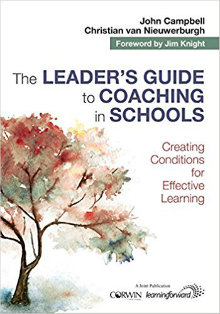A Helpful Guide to Coaching in Schools
The Leader’s Guide to Coaching in Schools: Creating Conditions for Effective Learning
By John Campbell and Christian van Nieuwerburgh
(Corwin/Learning Forward, 2017 – Learn more)

It was not many years ago that I was first introduced to the concept of instructional coaching.
My school district had created several coaching positions at the elementary, middle, and high school levels, with initial funding connected to our participation in the Race to the Top competitive grant program run by the Obama administration.
I had vague recollections of other districts that used coaches, but I wasn’t really sure what they did. Even when my district moved several amazing teachers into instructional coaching positions, this new role was still somewhat nebulous.

It wasn’t until about three decades later that the term began being used in an athletic sense and the instructional sense faded away until the late 1900s.
How coaches see their role
I recently asked some of the instructional coaches I knew how they would define their jobs, and most struggled to come up with a concrete answer. The most definite response was that “instructional coaching is classroom-embedded professional development for teachers.”
Other teachers chimed in with comments on what instructional coaches had done for them, but being able to identify some of the things that these coaches do is different from having a clear definition of what makes one an instructional coach.
Around the same time as I was trying to understand the role of my district’s instructional coaches, I was asked to take on a new role as a formal mentor to new teachers in my district. During the new teacher mentor training I attended, we were encouraged to use a coaching approach when working with our protégés. This definitely got me thinking: what is an instructional coach and what is a coaching approach?
Formal and informal approaches to coaching
Fortunately, I am not the only person to ask that question. In fact, it is a hotly debated topic in many educational circles, and so John Campbell and Christian van Nieuwerburgh, two educators on opposite sides of the world who happened to meet and discovered a shared interest, set out to define coaching and describe how it can be used in school settings, both in a formal way through instructional coaching and through a more informal coaching approach.
One of the first things I realized while reading their book is that, even when trying to give a concise definition of coaching, there are still dozens of ways to define it depending on the context of the role.
At its heart, the authors define coaching as “a one-to-one conversation that focuses on the enhancement of learning and development through increasing self-awareness and a sense of personal responsibility, where the coach facilitates the self-directed learning of the coachee through questioning, active listening, and appropriate challenge in a supportive and encouraging climate.”
With that definition in mind, Campbell and van Nieuwerburgh lay out their view of coaching and how it can be used in different school settings. Starting with the Global Framework for Coaching in Education, they identify four broad areas of interest for coaching: student success and well-being, educational leadership, professional practice, and community engagement.
The GROWTH model
They argue that all of these areas can benefit from coaching skills, the GROWTH model, and establishing a coaching way of being. The GROWTH model is an eight-step process that can be used to guide coaching sessions: after establish trusting relationships, the coach and coachee discuss Goals of the coaching process, Realities of the current situation, Options for change, what Will be done first, the Tactics for accomplishing tasks, and the sustainable Habits needed to ensure success, with a celebration of positive results at the end.
In addition to formal coaching, the authors acknowledge that a coaching approach can be used by school leaders to establish more meaningful discussions among teachers or other staff and for teachers to communicate with families in a way that establishes and reinforces a shared responsibility for student success.
Finally, they demonstrate how a school leader can adapt a formal performance evaluation by using a coaching approach so that the employee can work on agreed-upon areas of growth without fear of judgment or negative consequences.
The heart of the coaching approach
As I read this book, I realized that one common pitfall of school leadership is the urge to present solutions to others instead of guiding them to coming up with their own solutions. This is a key element of instructional coaching: the coach does not identify what needs to be done; that is the role of the coachee. The coach provides resources and guidance once the change has been identified. This is the heart and soul of the coaching approach and the coaching way of being and a mindset that will benefit teachers, students, families, and school leaders.
Throughout the book, the authors provide tips for coaches, QR codes that link to videos to see coaching in action, and questions for reflection. With just ten chapters and approximately 125 pages, this quick read is a great resource for new leaders, new coaches, teacher mentors, and those who have been in any of these roles but are looking for a fresh take on a venerable idea.
Alex T. Valencic, Ed.M., is a fourth grade teacher in Urbana, Illinois. He has taught professionally for ten years. When not teaching, Valencic can be found reading, riding his bicycle, volunteering with the Boy Scouts of America, Operation Snowball, Inc., and the Cebrin Goodman Teen Institute, or spending time with his family. After allowing others to shave off all of his thick, curly hair on three different occasions to encourage students to tackle challenges such as collectively reading 1,000,000 minutes, completing 1,000,000 math problems, or raising money for Jump Rope for Heart, he is happy to have all of his hair back! You can learn more about his adventures in teaching fourth grade by visiting his blog at Adventures in Teaching Fourth or by following him on Twitter @alextvalencic.

































